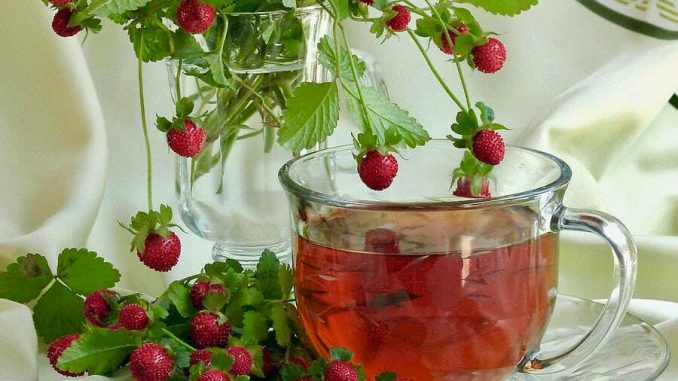
Recently while walking along the fields at the farm I noticed a leafy little plant with white flowers that reminded me of a strawberry, so I decided to look it up and that’s exactly what it was. Some other names that it goes by are the Woodland strawberry, European strawberry and alpine strawberry. When you see it you may need to understand that it is not the strawberry you’re used to seeing growing in our gardens.
The leaves are smaller and so is the fruit and flower, but it is the ancestor to the modern strawberries. This type of strawberry is the best type to forage for rather than the modern strawberries due to the fact that the leaves have a far better nutrient and medicinal quality. It is rich in iron and potassium as well as vitamins B, C & E and is excellent for people suffering from anemia. It commonly grows in fields and ditches throughout North America.
Medicinal Uses
The dried leave has been used for many years as a gentle astringent internally for urinary tract infections, diarrhea and digestive upset, to decrease inflammation in the liver, to treat gout, arthritis and kidney disease. It also has a significant anti-inflammatory effect that can be used not just internally but externally on parts of the body such as – the gums, for a sore throat, mouth sores, wounds and hemorrhoids. The small fruit can be crushed and used as a treatment for mild sunburn or to whiten the teeth or to lighten the complexion. It is also suggested that before medicinal use to test the leaves and or fruit pulp on the skin to determine if you may be allergic to strawberries since many people do have allergies to them. Some books say that wild strawberry can have an effect on the uterus and should be avoided by pregnant women and other books say that it can actually prevent miscarriages and hemorrhages in pregnant women. It is considered safe for children and they can eat the fresh or dried leaves or fruit to receive their nutrients and/or medicinal properties.
Recommended Dosage
To make a general nutrient tea –
One teaspoon of the dried wild strawberry leaves (2-3 teaspoons of fresh leaves) added to 1 cup of boiling water and soak for 10-15 minutes before straining. Using only the root for can have an anti-diarrheal effect.
I also recommend reading the book called “Jude’s Herbal Home Remedies” due to the fact that she has several wonderful herbal remedies that include wild strawberry, which treat a wide variety of issues. She is also a master herbalist with many years of experience.
As always consult a doctor who is familiar with herbalism and/or a master herbalist for the exact dosage required for the intended purpose or when blending this wild herb with other wild herbs.
When and What to Pick
In North America it is best to pick the plant from April through June. All parts of the plant can be used, but the fruit will come later in June depending on your area. The root of the wild strawberry has been used medicinally in the past primarily to treat diarrhea. Remember to pick responsibly and to pick only for what your intended need is medicinally or nutritionally. Also remember to always pick from areas that are not sprayed with herbicides or pesticides or any other type of poison.
Spiritual Purposes
The leaves, flowers and fruit can be used in energy work to inspire love and luck. It is considered a feminine plant that is ruled over by the planet Venus and the element of water as well as the goddess Freya. The fruit is served to express love and the leaves are carried for luck. Small satchels of strawberry leaves were carried by pregnant women in the past to ease their pregnancy pains and to give them luck during childbirth.
My Foraging Journey
Through my study I have discovered that this humble little plant has a multitude of uses. It is sweet and small and delicate and unassuming yet it has such wonderful gifts to give us if we just give it space to grow. My plan for the strawberry leaves that I have foraged is to add them in combination with other herbs to help potentially treat my IBS and colitis. As I have been discovering there are many wild herbs right near my doorstep that could help my body to heal. When I put my tea together to assist me with my IBS and colitis it is my plan to share it with everyone here and the results of taking it.
Until next time happy foraging and…
Namaste!
Supporting References
Breverton, Terry: Breverton’s Complete Herbal. Guilford, Connecticut, Lyons Press 2011. Based on Culpeper’s The English Physitian and Compleat Herball of 1653. (Yes, it is misspelled right.)
Bown, Deni: The Royal Horticultural Society New Encyclopedia of Herbs & Their Uses. London, Dorling Kindersley 2002.
Cunningham, Scott: Cunningham’s Encyclopedia of Magical Herbs. St. Paul, MN, Llewelyn Publications 1990.
Hensel, Wolfgang: Medicinal Plants of Britain and Europe. London, A&C Black Publishers Ltd. 2008.
Ody, Penelope: The Complete Medicinal Herbal. New York, NY, DK Publishing, Inc. 1993.
Peterson, Lee Allen: Edible Wild Plants Eastern/Central North America. Boston, New York, Houghton Mifflin Company 1977.
Van Wyk, Ben-Erik & Michael Wink: Medicinal Plants of the World. Portland, Oregon, Timber Press 2004.
Williams, Jude C.: Jude’s Herbal Home Remedies. St. Paul, MN, Llewelyn Publications 2001.


Leave a Reply